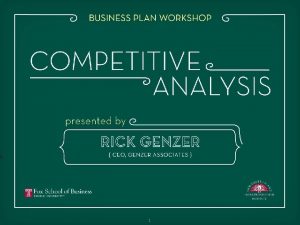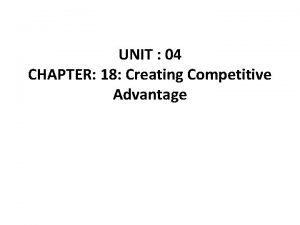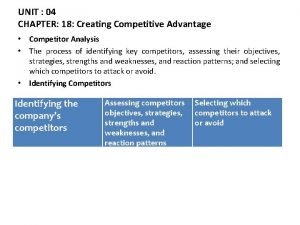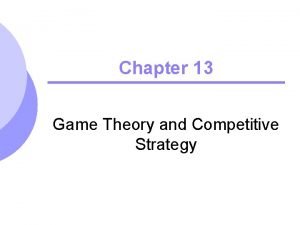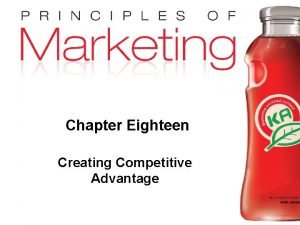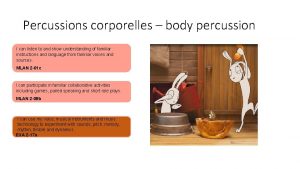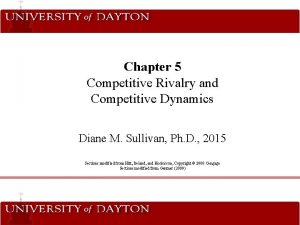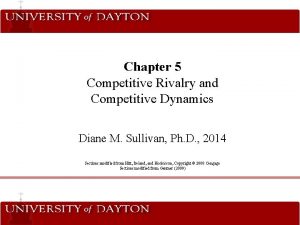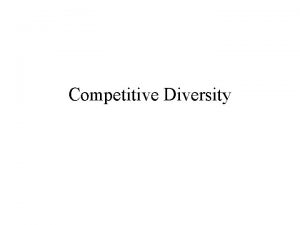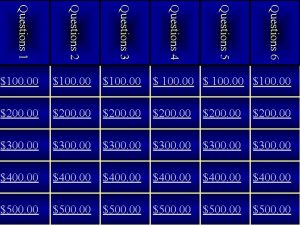1 11 Competitive Dynamics Chapter Questions How can





























- Slides: 29

1 11 Competitive Dynamics

Chapter Questions § § § How can market leaders expand the total market and defend market share? How should market challengers attack market leaders? How can market followers or nichers compete effectively? What marketing strategies are appropriate at each stage of the product life cycle? How should marketers adjust their strategies and tactics for an economic downturn or recession? Copyright © 2011 Pearson Education, Inc. Publishing as Prentice Hall 11 -2

Figure 11. 1 Hypothetical Market Structure Copyright © 2011 Pearson Education, Inc. Publishing as Prentice Hall 11 -3

Expanding the Total Market Copyright © 2011 Pearson Education, Inc. Publishing as Prentice Hall 11 -4

New Ways to Use a Brand Copyright © 2011 Pearson Education, Inc. Publishing as Prentice Hall 11 -5

Protecting Market Share Responsive anticipation Creative anticipation Copyright © 2011 Pearson Education, Inc. Publishing as Prentice Hall 11 -6

Figure 11. 2 Types of Defense Strategies Copyright © 2011 Pearson Education, Inc. Publishing as Prentice Hall 11 -7

Figure 11. 3 The Concept of Optimal Market Share Copyright © 2011 Pearson Education, Inc. Publishing as Prentice Hall 11 -8

Market Challenger Strategies § § § Define the strategic objective and opponents Choose a general attack strategy Choose a specific attack strategy Copyright © 2011 Pearson Education, Inc. Publishing as Prentice Hall 11 -9

General Attack Strategies § § § Frontal attack Flank attack Encirclement attack Bypass attack Guerilla warfare Copyright © 2011 Pearson Education, Inc. Publishing as Prentice Hall 11 -10

Specific Attack Strategies § § § Price discounts Lower-priced goods Value-priced goods Prestige goods Product proliferation Product innovation § § Improved services Distribution innovation Manufacturing-cost reduction Intensive advertising promotion Copyright © 2011 Pearson Education, Inc. Publishing as Prentice Hall 11 -11

Market Follower Strategies Copyright © 2011 Pearson Education, Inc. Publishing as Prentice Hall 11 -12

Market Nicher Strategies Copyright © 2011 Pearson Education, Inc. Publishing as Prentice Hall 11 -13

Niche Specialist Roles § § § End-User Specialist Vertical-Level Specialist Customer-Size Specialist Specific-Customer Specialist Geographic Specialist § § § Product-Line Specialist Job-Shop Specialist Quality-Price Specialist Service-Specialist Channel Specialist Copyright © 2011 Pearson Education, Inc. Publishing as Prentice Hall 11 -14

Product Life Cycles Copyright © 2011 Pearson Education, Inc. Publishing as Prentice Hall 11 -15

Figure 11. 4 Sales and Profit Life Cycles Copyright © 2011 Pearson Education, Inc. Publishing as Prentice Hall 11 -16

Figure 11. 5 a Common PLC Patterns: Growth-Slump-Maturity Copyright © 2011 Pearson Education, Inc. Publishing as Prentice Hall 11 -17

Figure 11. 5 b Common PLC Patterns: Cycle-Recycle Copyright © 2011 Pearson Education, Inc. Publishing as Prentice Hall 11 -18

Figure 11. 5 c Common PLC Patterns: Scalloped Copyright © 2011 Pearson Education, Inc. Publishing as Prentice Hall 11 -19

Figure 11. 6 Style, Fashion, and Fad Life Cycles Copyright © 2011 Pearson Education, Inc. Publishing as Prentice Hall 11 -20

Maintaining a Market Advantage: Trivial Pursuit Copyright © 2011 Pearson Education, Inc. Publishing as Prentice Hall 11 -21

Strategies for Developing a Pioneer Advantage Copyright © 2011 Pearson Education, Inc. Publishing as Prentice Hall 11 -22

Growth Stage Strategies Copyright © 2011 Pearson Education, Inc. Publishing as Prentice Hall 11 -23

Electrolux Copyright © 2011 Pearson Education, Inc. Publishing as Prentice Hall 11 -24

Changing Brand Course Market Modification Product Modification Marketing Program Modification Copyright © 2011 Pearson Education, Inc. Publishing as Prentice Hall 11 -25

Decline § § Declining sales Low cost per customer Declining profits Laggards Copyright © 2011 Pearson Education, Inc. Publishing as Prentice Hall 11 -26

Marketing in an Economic Downturn § § § Invest Get close to customers Review budgets Use a compelling value proposition Fine-tune offerings Copyright © 2011 Pearson Education, Inc. Publishing as Prentice Hall 11 -27

A Compelling Value Proposition Copyright © 2011 Pearson Education, Inc. Publishing as Prentice Hall 11 -28

For Review § § § How can market leaders expand the total market and defend market share? How should market challengers attack market leaders? How can market followers or nichers compete effectively? What marketing strategies are appropriate at each stage of the product life cycle? How should marketers adjust their strategies and tactics for an economic downturn or recession? Copyright © 2011 Pearson Education, Inc. Publishing as Prentice Hall 11 -29
 Rivalry chapter 5
Rivalry chapter 5 Which market is the least competitive
Which market is the least competitive Competitive antagonist
Competitive antagonist Entrepreneurial strategy and competitive dynamics
Entrepreneurial strategy and competitive dynamics Managing global competitive dynamics
Managing global competitive dynamics Competitive dynamics
Competitive dynamics Dynamics
Dynamics Chapter 18 creating competitive advantage
Chapter 18 creating competitive advantage Chapter 18 creating competitive advantage
Chapter 18 creating competitive advantage Chapter 5 the five generic competitive strategies
Chapter 5 the five generic competitive strategies Chapter 13 game theory and competitive strategy
Chapter 13 game theory and competitive strategy Chapter 2 strategic planning for competitive advantage
Chapter 2 strategic planning for competitive advantage Chapter 18 creating competitive advantage
Chapter 18 creating competitive advantage Firms in competitive markets chapter 14 ppt
Firms in competitive markets chapter 14 ppt Chapter 18 creating competitive advantage
Chapter 18 creating competitive advantage Study guide chapter 4 section 1 population dynamics
Study guide chapter 4 section 1 population dynamics Chapter 4 cultural dynamics in assessing global markets
Chapter 4 cultural dynamics in assessing global markets Chapter 4 population ecology test answer key
Chapter 4 population ecology test answer key Chapter 4 section 1 population dynamics
Chapter 4 section 1 population dynamics Chapter 4 population ecology answer key
Chapter 4 population ecology answer key Chapter 4 statics
Chapter 4 statics The dynamics of business and economics
The dynamics of business and economics Chapter 1 the dynamics of business and economics
Chapter 1 the dynamics of business and economics Mechanics for engineers
Mechanics for engineers If you can imagine it you can achieve it
If you can imagine it you can achieve it You can tell harris about it just ____(easily) as i can.
You can tell harris about it just ____(easily) as i can. If you think you can you can poem
If you think you can you can poem You are what you measure quote
You are what you measure quote If you can't measure it you cannot improve it
If you can't measure it you cannot improve it Can can body percussion
Can can body percussion





